 Written by Steven Hansen
Written by Steven Hansen
The headline seasonally adjusted BLS job growth was well above expectations. The internals generally look good.
Analyst Opinion of the BLS Employment Situation
The household and establishment surveys were in sync. The year-to-date employment is running above the pace of last year. This was a strong report.
- The year-over-year rate of growth for employment accelerated this month (blue bars on graph below). This is a year-over-year analysis which has no seasonality issues.

- Economic intuitive sectors of employment were mixed with temporary help contracting.
- This month’s report internals (comparing household to establishment data sets) was fairly consistent with the household survey showing seasonally adjusted employment expanding 293,000 vs the headline establishment number expanding 223,000. The point here is that part of the headlines are from the household survey (such as the unemployment rate) and part is from the establishment survey (job growth). From a survey control point of view – the common element is jobs growth – and if they do not match, your confidence in either survey is diminished. [note that the household survey includes ALL jobs growth, not just non-farm).
- The household survey added 12,000 people to the labor force.
- The National Federation of Independent Business (NFIB)’s monthly Jobs Report is at the end of this post.
A summary of the employment situation:
- BLS reported: 223K (non-farm) and 218K (non-farm private). Unemployment rate fell from 3.9 % to 3.8 %.
- ADP reported: 178K (non-farm private)
- In Econintersect‘s May 2018 economic forecast released in late April, we estimated non-farm private payroll growth at 185,000 (based on economic potential) and 230,000 (fudged based on current overrun / under-run of economic potential).
- The market expected (from Bloomberg / Econoday):
| Seasonally Adjusted Data | Consensus Range | Consensus | Actual | |
| Nonfarm Payrolls – M/M change | 155,000 to 215,000 | 185,000 | 223,000 | |
| Unemployment Rate – Level | 3.9 % to 4.0 % | 3.9 % | 3.8 % | |
| Private Payrolls – M/M change | 150,000 to 205,000 | 185,000 | 218,000 | |
| Manufacturing Payrolls – M/M change | 8,000 to 25,000 | 18,000 | 18,000 | |
| Participation Rate – level | 62.8 % to 62.9 % | 62.8 % | 62.7 % | |
| Average Hourly Earnings – M/M change | 0.2 % to 0.3 % | 0.2 % | +0.3 % | |
| Average Hourly Earnings – Y/Y change | 2.6 % to 2.8 % | 2.7 % | +2.7 % | |
| Av Workweek – All Employees |
| 34.5 hrs | 34.5 hrs |
The BLS reports seasonally adjusted data – manipulated with multiple seasonal adjustment factors, and Econintersect believes the unadjusted data gives a clearer picture of the jobs situation.
Non-seasonally adjusted non-farm payrolls expanded 991,000 – best growth this century for Mays. The following chart compares the jobs gains this month with the same month historically:
Year-to-date unadjusted employment growth is 109,000 people above the pace of last year.
Last month’s headline employment gains were revised downward. Generally speaking, employment is overstated when the economy is slowing and understated when the economy is accelerating.

Most of the analysis below uses unadjusted data, and presents an alternative view to the headline data.
Unemployment
The BLS reported U-3 (headline) unemployment was 3.8 % with the U-6 “all in” unemployment rate (including those working part time who want a full time job) was revised from 7.8 % to 7.6 %. These numbers are volatile as they are created from the household survey.
BLS U-3 Headline Unemployment (red line, left axis), U-6 All In Unemployment (blue line, left axis), and Median Duration of Unemployment (green line, right axis)

Econintersect has an interpretation of employment supply slack using the BLS employment-population ratio, demonstrated by the graph below. The employment-population ratio declined from 60.4 to 60.3.
Employment-Population Ratio
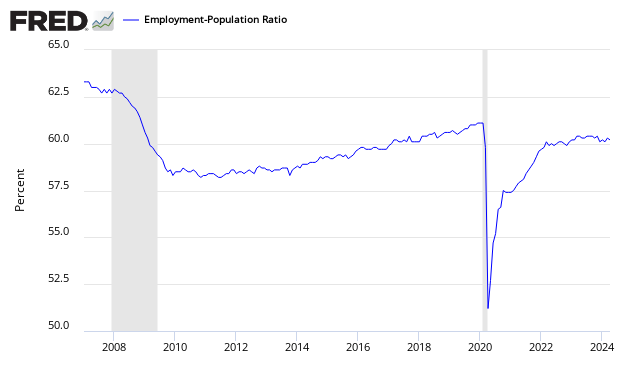
The jobs picture – when the employment / population as a whole – has been on an uptrend since mid-2011. This ratio is determined by household survey.
- Econintersect uses employment-populations ratios to monitor the jobless situation. The headline unemployment number requires the BLS to guess at the size of the workforce, then guess again who is employed or not employed. In employment – population ratios, the population is a given and the guess is who is employed.
- This ratio has been in a general uptrend since the beginning of 2014. The employment-population ratio tells you the percent of the population with a job. Each 0.1 % increment represents approximately 300,000 jobs. [Note: these are seasonally adjusted numbers – and we are relying on the BLS to get this seasonal adjustment factor correct]. An unchanged ratio would be telling you that jobs growth was around 150,000 – as this is approximately the new entries to the labor market caused by population growth.
- The growth in employment since the Great Recession has been in full-time jobs.
Employment Metrics
The growth trend in the establishment survey’s non-farm payroll year-over-year growth rate was trending up beginning of 2014 but has been trending down beginning in 2015. Year-over-year growth rate improved this month.
Unadjusted Non-Farm Payrolls Year-over-Year Growth
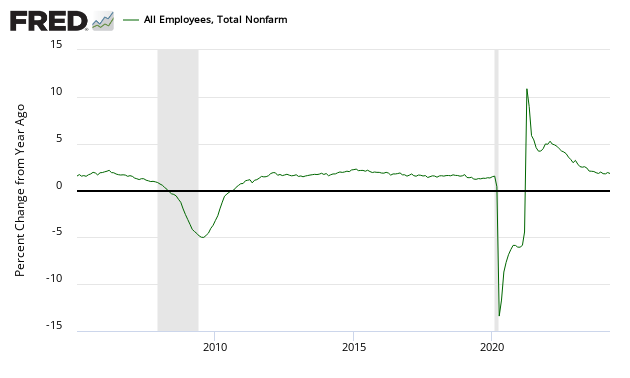
Another way to view employment is to watch the total hours worked which no clear trend is obvious.
Percent Change Year-over-Year Non-Farm Private Weekly Hours Worked
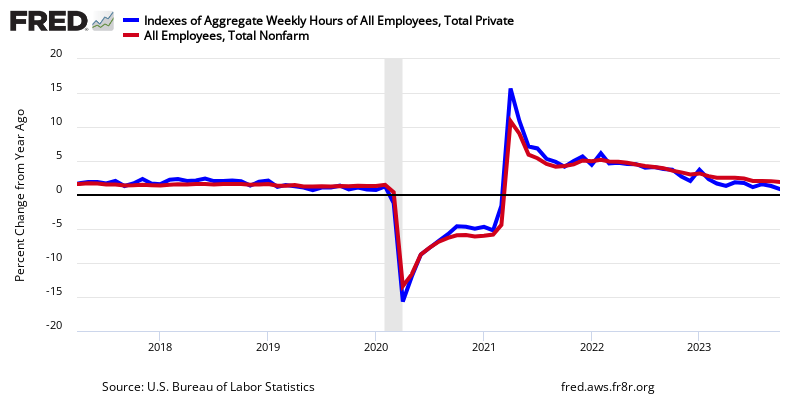
The bullets below use seasonally adjusted data from the establishment survey except where indicated:
- Average hours worked (table B-2) was unchanged at 34.5. A rising number normally indicates an expanding economy .
- Government employment gained 5,000 (5K) with the Federal Government down 3K, state governments up 2K and local governments up 6K.
- The big contributors to employment growth this month was health care (28.9K), retail trade (31K), and construction (25K).
- Manufacturing was up 18K, and construction was up 25K.
- The unemployment rate (from household survey) for people between 20 and 24 (Table A-10) degraded 0.4 to 7.1 %. This number is produced by survey and is very volatile.
- Average hourly earnings (Table B-3) was up $0.08 to $26.92.
Private Employment: Average Hourly Earnings

Economic Metrics
Economic markers used to benchmark economic growth (all from the establishment survey).
The truck employment was up 6.6K.
Truck Transport Employment – Year-over-Year Change
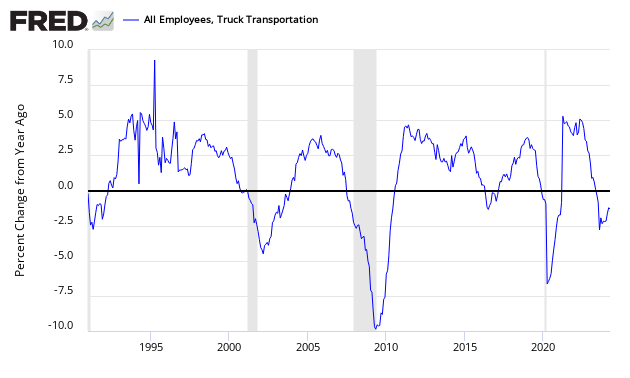
Temporary help was down 7.8K.
Temporary Help Employment – Year-over-Year Change
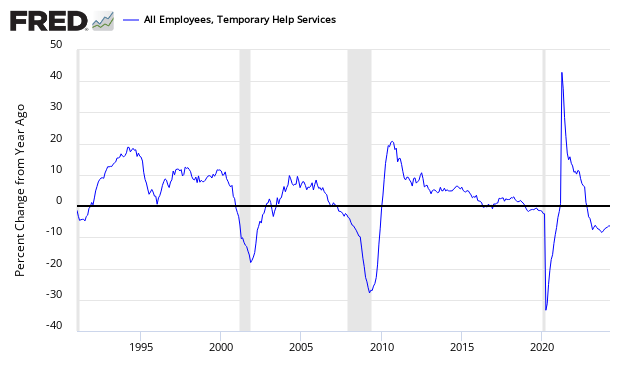
Econintersect believes the transport sector is a forward indicator. Others look at temporary help as a forward indicator.
Food for Thought
Who are the victims in this employment situation. It is not people over 55.
Index of Employment Levels – 55 and up (blue line), 45 to 54 (red line), 35 to 44 (green line), 25 to 34 (purple line), 20 to 24 (light blue line), and 16 to 19 (orange line)

Women are doing better than men.
Index of Employment Levels – Men (blue line) vs Women (red line)

Mom and Pop employment remains below recessionary levels.

The less education one has, the less chance of finding a job.
Index of Employment Levels – University graduate (blue line), Some college or AA degree (orange line), high school graduates (green line), and high school dropouts (red line)

Here is an indexed view of employment levels.
Index of Employment Levels (from the BLS Establishment Survey) – Hispanic (blue line), African American (red line), and White (green line)

However, keep in mind that population growth is different for each group. Here is a look at employment to population ratios which clearly shows NO group has recovered from the Great Recession:
Employment / Population Ratios (from the BLS Household Survey) – Hispanic (blue line), African American (red line), and White (green line)

National Federation of Independent Business (NFIB)’s monthly Jobs Report Statement:
Record high levels of small business owners are reporting increased employee compensation and hiring numbers continue to grow, according to NFIB’s monthly Jobs Report. A seasonally adjusted net 35 percent of small business owners reported increases in labor compensation as owners try to attract needed employees and retain those already on board. Fifty-eight percent of respondents indicated they are hiring or trying to hire, up one point in the past month and five points since the March report.
“This month’s jobs report demonstrates that small business owners’ optimism is showing no signs of abating. They are increasing compensation at record levels and are continuing to hire,” said NFIB President and CEO Juanita Duggan. “Post tax reform, concerns about taxes and regulations are taking a backseat to their worries over filling open positions and finding qualified candidates.”
While near-record high levels of owners are hiring or trying to hire, 83 percent of respondents reported few or no qualified applicants for the positions they were trying to fill. Twenty-three percent of owners cited the difficulty of finding qualified workers as their Single Most Important Business Problem (up one point), the highest reading since 2000, and one point below the all-time survey high.
Thirty-three percent of all owners reported job openings they could not fill in the current period, down two points but historically very high. Twelve percent reported using temporary workers, unchanged.
“While the small business economy is showing tremendous growth, difficulty finding qualified workers continues to be a notable issue,” said NFIB Chief Economist Bill Dunkelberg. “Temporary workers are filling some of these vacancies, but an increased availability of qualified workers would lead to more growth in employment.”
Click here to view the entire NFIB Jobs Report. For more information about NFIB, please visit www.nfib.com.
Caveat on the use of BLS Jobs Data
The monthly headline data ends up being significantly revised for months after the initial release – and is subject also to annual revisions. The question remains how seriously can you take the data when first released.
Econintersect Contributor Jeff Miller has the following description of BLS methodology:
- An initial report of a survey of establishments. Even if the survey sample was perfect (and we all know that it is not) and the response rate was 100% (which it is not) the sampling error alone for a 90% confidence interval is +/- 100K jobs.
- The report is revised to reflect additional responses over the next two months.
- There is an adjustment to account for job creation — much maligned and misunderstood by nearly everyone.
- The final data are benchmarked against the state employment data every year. This usually shows that the overall process was very good, but it led to major downward adjustments at the time of the recession. More recently, the BLS estimates have been too low.
ADP (blue line) versus BLS (red line) – Monthly Jobs Growth Comparison

However, there is some discussion that neither the ADP nor BLS numbers are correct – as both are derived by a sampling methodology. The answer could be that there is no correct answer in real time – and that it is best to look at the trends. As has been noted, all eventually end up correlating.
The BLS uses seasonal adjusted data for its headline numbers. The seasonally adjusted employment data is produced by an algorithm. The following graph which shows unadjusted job growth – seasonal adjustments spread employment growth over the entire year. Employment does not really grow in the second half of the year and always falls significantly in January.
Non-Seasonally Adjusted Employment – Private Sector
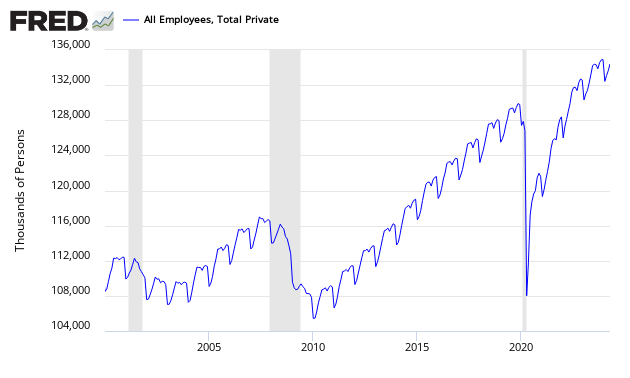
There is the proverbial question on what is minimal jobs growth each month required to allow for new entrants to the market. Depending on mindset, this answer varies. According to Investopdia, the number is between 100,000 and 150,000. The Wall Street Journal is citing 125K. Mark Zandi said 150K. Econintersect is going with Mark Zandi’s number:
- In Econintersect‘s June 2014 economic forecast released in late May, we estimated non-farm payroll growth at 160,000 (unadjusted based on economic potential) and 229,000 (fudged based on current overrun of economic potential).
- If Econintersect uses employment – population ratios, the correct number would be the number where this ratio improved. Using the graph below, the ratio began to improve starting a little after mid-year. This corresponds to the period where the 12 month rolling average of job gains hit 150,000.
Employment to Population Ratio

Note: The ratio could be fine tuned by adjusting to the ratio of employment to working age population rather than the total population. However, this would not change the big picture that an increase of somewhere around 150,000 (+/-) is needed for the growing population numbers. We have estimated 140k – 160k. The number might possibly be within the range 125k – 175k. Econintersect cannot find reason to support the estimates below 125k.
The question of how changing demographics impact the employment numbers is at the margins of analysis. Econintersect will publish more on this fine tuning going forward, both in-house research and the work of others.
include(“/home/aleta/public_html/files/ad_openx.htm”); ?>










